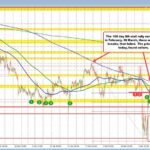
Decoding AUD/USD: Navigating Complex Market Dynamics
Tháng 4 11, 2025Historic Rise: US 30-Year Treasury Bond Yield Soars to 4.95% – What It Means for the Economy
Tháng 4 11, 202530-Year U.S. Treasury Bond Yields Set for Largest Weekly Surge Since 1982: An In-Depth Analysis
Recent trends in the U.S. Treasury market indicate that 30-year bond yields are on track to experience their most significant weekly increase since 1982, with current yields reaching around 4.95%. This unprecedented rise can be attributed to a confluence of economic factors that are shaping investor sentiment and expectations within the volatile financial landscape.
Key Factors Driving the Increase in Yields
Rising Inflation Expectations plays a critical role in the current surge in bond yields. Investors are becoming increasingly apprehensive about inflation, which drives a demand for higher yields to provide a hedge against the diminishing purchasing power of their money. As inflation erodes the value of returns, securing more substantial yields becomes essential for maintaining beneficial investment outcomes. To avoid common pitfalls linked to these sentiments, investors may find it helpful to explore key investment mistakes to avoid for long-term financial success as outlined in this blog on investment mistakes.
Budget Concerns are also contributing to the rising yield environment. Recent congressional actions regarding budget votes have raised alarms over the potential for larger deficits. This situation escalates fears about increased borrowing costs and exerts pressure on bond prices, further influencing yields upward. Investors are wary, as a heightened deficit often leads to more significant government borrowing, which can exert downward pressure on bond prices.
Furthermore, Economic Growth Issues manifest as additional contributing factors to the yield surge. As signs of a slowing U.S. economy surface, uncertainty looms over the markets. In response, market participants are seeking higher yields as protection against perceived risks associated with an economic downturn. When growth signals wane, the inclination towards safer, more lucrative investments intensifies. This phase might trigger psychological pitfalls, reminiscent of those highlighted in this blog on investment mistakes, suggesting that awareness of these tendencies is crucial during such turbulent times.
Moreover, a Loss of Confidence in the administration’s economic policies appears to be shaping market dynamics. As investor confidence wanes, the demand for riskier assets diminishes, further propelling investors toward higher yields in search of reassurance and stability amidst uncertainty.
Shifting global trends towards De-dollarization are playing a subtle yet significant role in the current trends affecting U.S. bonds. As countries pivot away from the dollar in their reserves, the demand for U.S. Treasury bonds may diminish, indirectly prompting higher yields as supply outstrips demand.
Lastly, the Federal Reserve’s Stance remains a pivotal factor in the equation. With a steadfast focus on inflation control, the Fed’s decisions—or lack thereof—concerning the bond market contribute directly to rising yields. Investors speculate that the current high-rate environment will persist in the short term, influencing their investment strategies accordingly. The relationship between the Fed’s stance and market performance underscores the importance of disciplined investment strategies, as explained in this analysis of value investing.
Implications of Rising Yields
The implications of climbing 30-year yields are far-reaching and can significantly influence various facets of the economy. An immediate consequence is the potential increase in Mortgage Rates. As yields rise, mortgage costs typically follow suit, which can adversely affect housing affordability and slow down real estate markets, leading to a ripple effect across the economy.
Another area of concern is Corporate Borrowing Costs. Higher yields mean corporations may face increased expenses when issuing new debt. This scenario can lead to reduced capital expenditures, crimping business investment, and ultimately potentially stagnating economic growth.
Lastly, the overarching Overall Economic Sentiment may become adversely affected by rising yields. If they signal increased uncertainty or recessionary conditions, consumer and business confidence may take a dive, leading to a more cautious approach in spending and investment.
In summary, this week’s developments reflect a complex interplay of economic signals and market expectations. Investors are equipped with critical insights to navigate this uniquely challenging financial environment as 30-year Treasury yields soar to unprecedented heights. As these trends continue to unfold, staying informed will be key for stakeholders in the financial market.
